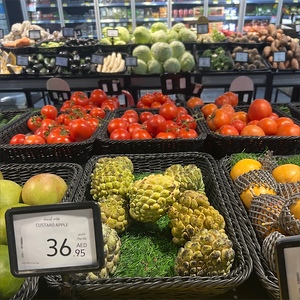


Custard Apples (Austrailian)
Estimated Inventory, lb : 0
Description/Taste
Australian custard apples are medium to large in size and oblate to heart-shaped, averaging 8-16 centimeters in diameter and weighing 1-4 pounds. The skin is thin, tough, and knobbly with dark green flesh when young, and lightens to a pea-green or yellow-green when ripe. The cream-colored flesh is soft and custard-like and encased in the flesh there are up to twelve hard, brown or black inedible seeds. Australian custard apples are juicy, creamy, sweet, and fragrant with a tropical aroma and hints of vanilla. Australian custard apples grow on trees that grow to ten meters in height. In addition to the fruit, the trees bear large, green drooping leaves and yellow trumpet-shaped flowers.
Seasons/Availability
Australian custard apples are available in the fall and winter.
Current Facts
Australian custard apples, botanically classified as Annona reticulata, are a sub-tropical fruit that belongs to the Annonaceae family. Australian custard apples are a hybrid of a cross between the sugar apple or sweetsop and the cherimoya, and the popular varieties cultivated in Australia are Pinks Mammoth, African pride, Maroochy Gold, KJ Pinks, and Tropic Sun. Australian custard apples are consumed as a dessert fruit and are favored for their sweet and uniquely creamy texture.
Nutritional Value
Australian custard apples are an excellent source of vitamin B, vitamin C, iron, potassium, magnesium, copper, and dietary fiber.
Applications
Australian custard apples are best suited for raw consumption. They can be cut it in half, served with shredded coconut, nuts, light cream, or sugar, and scooped out with a spoon to be eaten fresh. The pulp can also be used in salads, smoothies, ice creams, blended into baked goods like muffins and crumbles and can be served with honey, low-fat ricotta, and cinnamon on bread as a bruschetta. Australian custard apples pair well with vanilla, cinnamon, ginger, honey, nutmeg, orange, pineapple, banana, papaya, and pineapple. To check if an Australian custard apple is ripe, gently squeeze it. It should have some give to it like an avocado. If the fruit is hard to the touch, keep it at room temperature or place it in a brown paper bag and allow it to ripen over several days. Once ripe, Australian custard apples will keep up to three days when stored in the refrigerator.
Ethnic/Cultural Info
Custard apples have been used around the world to reduce symptoms of colds, indigestion, pain, and to help promote healthy blood flow. In India, the juice of unripe fruit has been used to relieve symptoms from insect bites, and pastes created from the leaves helps to speed up healing time and destroy worms in wounds. It has also been used to help reduce symptoms of arthritis pain and diarrhea.
Geography/History
Atemoyas, the parent fruit of the Australian custard apple, is native to South America and were brought to Australia from Guyana in the 1890s. The first cultivar to be grown on Australian soil was the Pink’s Mammoth, and the development of many new Australian custard apple cultivars are the result of a breeding program in Queensland. Today, the main commercial production of Australian custard apples can be found on Australia’s east coast, from the tropics of Queensland to the sub-tropical areas of New South Wales. They can also be found in Southeast Asia.
Recipe Ideas
Recipes that include Custard Apples (Austrailian). One
| Custard Apples Australia |
|
Custard Apple Teacake |
| Yanalla Farms |
|
Custard Apple and Apple Pie |
| The Guardian |
|
Custard Apples with Deep-Fied Coconut Ice Cream |
















